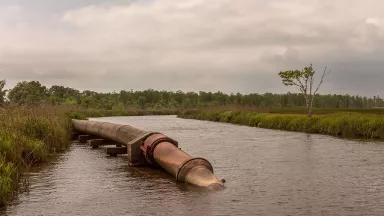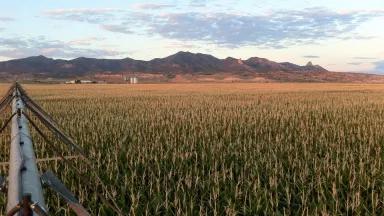In Colorado, Oil and PFAS Shouldn’t Mix
We can add PFAS contamination to the list of ways the oil and gas industry is threatening Coloradans’ health. Two new laws aim to stop it—but are they enough?

A brown cloud of pollution over Denver
When Deb Bjork, an avid hiker, moved to Fort Collins, Colorado, she looked forward to the scenic views and fresh mountain air. Instead, she has found herself living in a place the American Lung Association recently ranked 18th among the U.S. cities with the unhealthiest air to breathe. (Denver, an hour’s drive to the south, ranked seventh due to the region’s high ozone levels.)
“You take a hike in the foothills, and you look down and you see the brown cloud, but I had no idea how much was coming from fracking,” says Bjork, who was diagnosed with asthma in her forties, after she’d settled in Colorado.
But there’s another danger lurking out there. In addition to dirty air, Colorado’s oil and gas industry is also exposing residents to another type of pollution—only this one you can’t see. In order to frack for oil and gas, the industry pumps chemical cocktails into the ground to break up shale rock, and in doing so, it potentially contaminates groundwater. These cocktails can include a class of chemicals called perfluoroalkyl and polyfluoroalkyl substances (PFAS for short), exposure to which has been linked to a wide range of health problems including cancer, thyroid disease, developmental issues, and reproductive harm. They are referred to as “forever chemicals” because they are extremely resistant to breaking down in the environment, and they bioaccumulate in our bodies. In fact, the Centers for Disease Control and Prevention says PFAS can be found in the blood of nearly every person in the United States.
The prevalence of PFAS in our lives stems from these chemicals’ use in a wide variety of consumer products found in our food, clothes, and homes—particularly in items that make our goods water-, stain-, and grease-resistant. However, the use of PFAS by the oil and gas industry is not as well documented.
“The way that fracking destroys water is already really terrifying, and PFAS is yet another way that that happens,” says Kate Christensen, who leads fracking work for Colorado’s chapter of 350, a global climate action organization committed to ending fossil fuel use. The state has approximately 52,000 oil and gas wells, about 22,000 of which are in Weld County, just east of Fort Collins. And plans for thousands of new ones are currently in the works.
Bjork, a retired psychologist who volunteers with several local and national environmental groups, is also concerned about PFAS, particularly for the health of her five grandchildren who live locally. “But I doubt most people even know about it,” she says of the fracking-PFAS connection. “Most people don't even know there's bad air quality here. They have no idea.”

Fracking with toxic forever chemicals
The news that oil and gas companies were using PFAS in fracking operations first came to light in a July 2021 Physicians for Social Responsibility (PSR) report. Its authors found evidence in U.S. Environmental Protection Agency (EPA) records that PFAS had been used in more than 1,200 wells across six states between 2012 and 2020. The records, obtained by PSR under a Freedom of Information Act request, showed that, despite regulators’ concerns about three new PFAS chemicals potentially degrading into PFOA (a particularly harmful type of PFAS), the EPA approved them in 2010 for oil and gas drilling. After further research, PSR discovered that versions of the chemicals had been injected into thousands of wells.
The 2021 report did not include Colorado, but a yearlong Colorado-focused investigation by PSR’s Dusty Horwitt and Barbara Gottlieb soon followed. The results suggested that PFAS exposure was likely among many Coloradans, especially those who live in close proximity to oil and gas wells. Horwitt and Gottlieb’s analysis of industry data—listed on FracFocus, the official repository for oil and gas chemical disclosure in Colorado—determined that PFAS has been used in the state’s wells since at least 2008 and found evidence of its use in 10 counties, predominantly in Weld and Garfield.
“Oil and gas operations are particularly bad places to use PFAS—or any type of dangerous chemical—because there are so many different pathways of contamination,” Horwitt says. PFAS doesn’t just get into our water but our air, too, due to the methane-flaring methods the industry uses. “It's far too risky.”
Another study by Public Employees for Environmental Responsibility (PEER) found in October 2021 that Colorado may have more PFAS-contaminated sites than any other state, with 86 percent of those 21,000 sites involving the oil and gas industry.
In addition to aboveground leaks and spills at well sites, PFAS can leach into groundwater through cracks inside wells. Contamination can also occur before the actual fracking begins when companies drill straight into groundwater, or during or after the process through the injection or improper disposal of wastewater tainted with PFAS or other toxic chemicals. The refining process is another source of pollution, as seen recently in the waters near Suncor, Colorado’s sole oil refinery, located north of Denver. A study prepared for Earthjustice last April traced a large portion of the PFAS found in the Sand Creek and South Platte River to Suncor’s discharges. The waterways not only provide drinking water to several large municipalities downstream, but the South Platte is also critical to agricultural irrigation.

Lifting the veil of secrecy
While Horwitt says it is known that the fracking industry is using PFAS in its operations, he can’t say for sure how much or how often it’s been happening. That’s because of Colorado’s chemical disclosure exemptions, which allow oil and gas companies to withhold information about the substances they use in fracking, including PFAS, by claiming the formulas to be trade secrets. PSR found that between 2011 and 2021, oil and gas operators in Colorado injected almost 414 million pounds of mystery chemicals in 12,000 wells across 31 of Colorado’s counties. “If even a small fraction of this weight were PFAS, that fraction could pose significant health and environmental risks,” the report’s authors wrote.
But to advocates’ relief, starting at the end of July 2023 (as a result of a law that Governor Jared Polis signed last June), those exemptions are over. A new policy will require chemical manufacturers to certify that their products used in downhole oil and gas production don’t contain PFAS and to list every chemical they use in those operations—information which must be listed and publicly accessible on the website of the Colorado Oil & Gas Conservation Commission (COGCC).
Another new law, also signed by Polis in June, goes after PFAS more directly. Following the lead of states like California, it bans the unnecessary use of forever chemicals in consumer products such as cookware, cosmetics, food packaging, and carpets and rugs. And, in a first for the nation, this law also prohibits the use of PFAS in fluids used to extract oil and gas.
Ean Thomas Tafoya, who directs GreenLatinos’ Colorado work, credits the work of activists like Liz Rosenbaum and 11-year-old Madhvi Chittoor for the progress the state is making on PFAS and says public health advocacy efforts are reaching more Coloradans than ever. “COVID created more possibilities for remote testimony and that's been a gamechanger for community participation, especially if you live in rural Colorado,” says Tafoya. “I can directly say that improved democratic access played a huge part in the success we’ve had in regulating PFAS and other toxics.”
And that’s great news because even with the promise of these new laws, there’s still a lot of work to do. Sonya Lunder, senior toxics policy advisor for the Sierra Club, says the laws represent “a powerful nexus of the toxics and fracking conversations, but I don't think anyone is feeling like we've solved either problem completely.”
Lunder says we need more comprehensive change. “To find out that millions of pounds per year of the most harmful chemicals we know of in commerce could be used in the oil and gas industry, and nobody would know, just reveals the brokenness of the system,” she says. “Our vulnerability for this will happen again and again until there's some basic, rudimentary oversight over how things are made and how industry works in the United States. We’re very far from that point at the moment.”
In addition to the new laws, Horwitt says the state should go a step further and conduct testing near oil and gas wells for the presence of PFAS in groundwater, surface water, and soil to assess the extent of current contamination levels. He also encourages concerned residents to reach out to their elected officials to request such testing.

Colorado could lead the way
The federal government’s response to the PFAS crisis has not been sufficient. Currently, the it mostly regulates chemicals, including thousands of very similar PFAS, one at a time—and each assessment can take decades. For example, the EPA just proposed to designate two PFAS chemicals, PFOA and PFOS, as hazardous under Superfund law in August. The agency has taken a similar chemical-by-chemical approach to drinking water, and the federal government has also been slow to end the unnecessary uses of PFAS.
This is where states can step in to help fill the gap, explains Avinash Kar, a senior attorney who directs NRDC’s program on healthy food and communities. “There’s a groundswell of action at the state level to deal with PFAS, while the federal stuff has been in a bit of gridlock.” For instance, moves in California and New York to ban the entire class of PFAS in consumer products, such as textiles and food packaging, can change the national market, given the size of the states’ markets.
Colorado advocates similarly hope their state’s commitment to curbing PFAS, especially in the oil and gas industry, can be a model for other states. “Until we can shut the PFAS off, until we can figure out how to get them out of the water, we have a big responsibility in Colorado,” says Tafoya. “We’re a headwater state, and millions of people get their water from us, so we're a great place to really draw the line.”
Tell Columbia to stop using deadly PFAS chemicals in its products!

Tell Columbia to stop using deadly PFAS chemicals in its products!
This NRDC.org story is available for online republication by news media outlets or nonprofits under these conditions: The writer(s) must be credited with a byline; you must note prominently that the story was originally published by NRDC.org and link to the original; the story cannot be edited (beyond simple things such as grammar); you can’t resell the story in any form or grant republishing rights to other outlets; you can’t republish our material wholesale or automatically—you need to select stories individually; you can’t republish the photos or graphics on our site without specific permission; you should drop us a note to let us know when you’ve used one of our stories.









The Uinta Basin Railway Would Be a Bigger Carbon Bomb Than Willow
Mercury’s Journey from Coal-Burning Power Plants to Your Plate
Environmental Justice in Chicago: It’s Been One Battle After Another